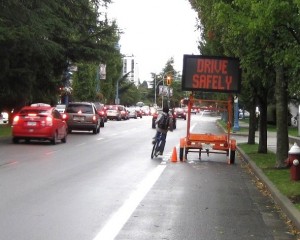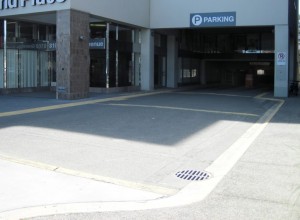In light of comments from someone whose opinions matter, I thought I would clarify the purpose of these posts a bit.
I am always first to point out that my bike route to work is pretty good, an example of what should be available to more people in more places. I don’t get all that concerned about the few little issues that pop up – because I am cognizant of how difficult it is to operate a City, and manage all of the little things that crop up, not to mention the hassles that typically go with living in a big urban area with 3 million other people.
So when they are tearing up a road to replace a water line, that doesn’t bother me. When they need to drill holes in a road and close a lane, and have lots of signs and flag persons, and I have to wait a minute to get on my way, that’s part of the deal of getting to use the infrastructure. Most drivers roll with that, and so do I when riding.
Sometimes commercial vehicles, for whatever reason, need to block a lane for an extended period of time to do their jobs. When that happens, they apply to the City for a temporary road closure permit, and set up appropriate safety flagging, signage, etc. The City I work for does not charge for this: the permits are free, a service your tax dollars provide. When driving or riding, you see these things as necessary and accept them as part of City life.
So when I complained about this commercial vehicle blocking the bike lane during rush hour, it was not just him being there, it was because we know he would not block the car lane during rush hour, and it is not like he had no alternative: this is the commercial loading zone less then 20 feet away where he chose not to park, because the bike lane was just too convenient:
But here is the best example I have found yet, one I griped about earlier, but fits as probably the model example of the Bicycle Lane Obstacle Course, one worthy of BLOC post #3:
 |
| damn cyclist, swerving all over the place, and not even wearing a helmet! |

I don’t disagree, Pat, as long as you recognize the differences: a motorist does not have the option of dismounting and walking (which barely registers when measured against the other of life’s many inconveniences). If such an obstacle were present in a driving lane, too bad so sad, you just have to sit there and wait for it to clear up (or become an even bigger hazard by swerving into another lane).
Also, on the “danger-to-others” scale, a cyclist swerving through people to avoid an obstacle isn’t remotely as dangerous as a car swerving into a bike lane to avoid an obstacle.
The things that can go wrong on a motorist’s commute are far more likely to result in either lengthy delays or personal injury than similar obstacles on a cyclists commute. This fact (hmm…is that a fact or just my opinion?) leads to 2 conclusions: 1)it’s more important to eliminate obstacles in driving lanes than in bike lanes, and 2)since it’s easier to avoid obstacles on a bike than in a car, more people should bike to work rather than drive.
I love the irony of that picture. More drivers would see it if it were in the driving lane.
But I think why these obstructions really bug us is that they communicate that the bike lane is just sort of optional extra space for stuff they didn’t have room for or don’t want to put in the “real” lanes. Or in the parking lane – can’t block that! Yes, I can go around it easily when I’m riding. But it still puts that little black cloud above my head and the grrrs in my heart.
I see this as very much a chicken and egg problem. The city doesn’t work so hard to keep bike lanes clear and obstacle free because relatively few people use them and those people that use them are fearless and seasoned cyclists that can handle merging lanes and jumping curbs. But a general lack of a safe bike network and obstacle free right of way, the majority of the population chooses other modes of travel.
I lived in Copenhagen in for half a year and any time the bike lane is blocked off for whatever reason, ramps, cones and barriers are set up to make a comfortable detour for bikes.